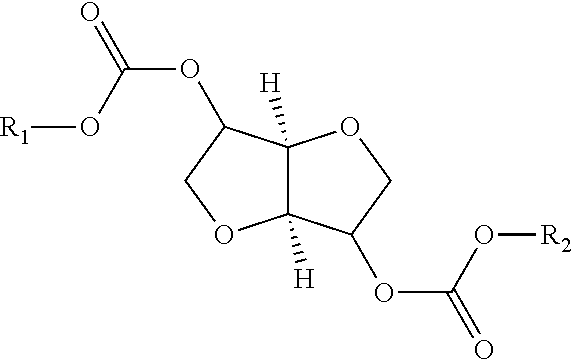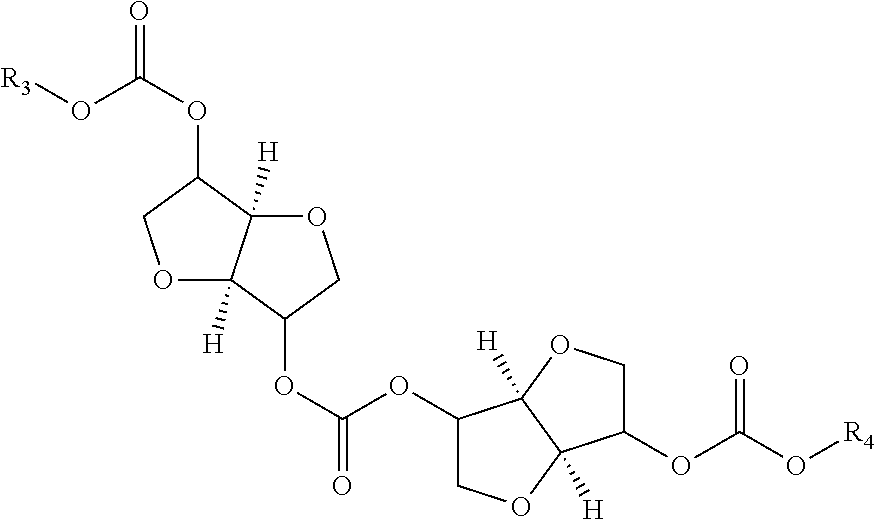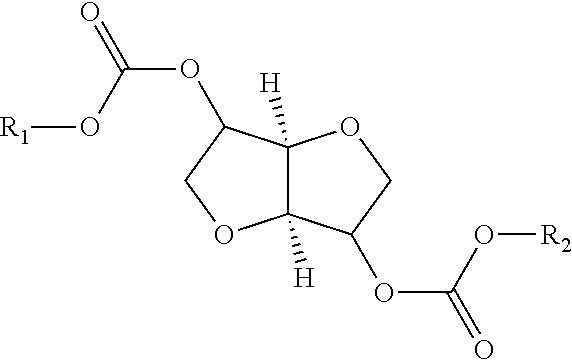Process for manufacturing polycarbonate from dianhydrohexitol dialkylcarbonate
a technology of dianhydrohexitol and dialkylcarbonate, which is applied in the field of new polycarbonate manufacturing processes, can solve the problems of toxic compound generation of phenol, and the yield obtained through these processes is generally unsatisfactory
- Summary
- Abstract
- Description
- Claims
- Application Information
AI Technical Summary
Benefits of technology
Problems solved by technology
Method used
Image
Examples
example 1
[0157]42.5 g (0.162 mol) of isosorbide dimethyl carbonate (A), 23.7 g (0.162 mol) of isosorbide (B), i.e. an (A) / (B) mole ratio of 1 / 1, and 0.0112 g (1.62×10−4 mol) of 1,2,4-triazole are placed in a 100 ml reactor, heated with a bath thermostatically maintained with a heat-exchange fluid, equipped with a mechanical stirring system with paddles, a system for controlling the temperature of the reaction medium, a nitrogen inlet tube, a distillation head connected to a condenser and to a container for receiving the condensates, and a regulated vacuum system. The installation is placed under an atmosphere of nitrogen and the reaction medium is heated by means of the heat-exchange fluid. The temperature is gradually increased in stages of 2 hours 30 minutes at 170° C., 1 hour at 200° C., 1 hour at 220° C. and 1 hour at 235° C. The temperature increase between each stage takes place over 30 minutes. In the course of the reaction, distillation of the methanol is observed. At the end of the ...
example 2
[0159]Example 1 is repeated, the only difference being that the isosorbide dimethylcarbonate (A) contains 21% by weight of dimers (C), conserving an ((A) +(C)) / (B) mole ratio of 1 / 1.
[0160]A polymer with a glass transition temperature of 120° C. is obtained.
[0161]The operating conditions are collated in table 1 below.
example 3
[0162]Example 2 is repeated, the only difference being that the isosorbide is replaced with isoidide, while conserving an ((A)+(C)) / (B) mole ratio of 1 / 1.
[0163]A polymer with a glass transition temperature of 85° C. is obtained.
[0164]The operating conditions are collated in table 1 below.
PUM
| Property | Measurement | Unit |
|---|---|---|
| Temperature | aaaaa | aaaaa |
| Temperature | aaaaa | aaaaa |
| Temperature | aaaaa | aaaaa |
Abstract
Description
Claims
Application Information
 Login to View More
Login to View More - R&D
- Intellectual Property
- Life Sciences
- Materials
- Tech Scout
- Unparalleled Data Quality
- Higher Quality Content
- 60% Fewer Hallucinations
Browse by: Latest US Patents, China's latest patents, Technical Efficacy Thesaurus, Application Domain, Technology Topic, Popular Technical Reports.
© 2025 PatSnap. All rights reserved.Legal|Privacy policy|Modern Slavery Act Transparency Statement|Sitemap|About US| Contact US: help@patsnap.com



